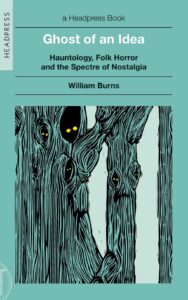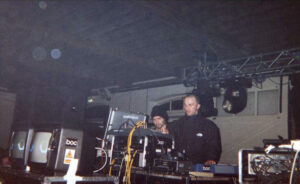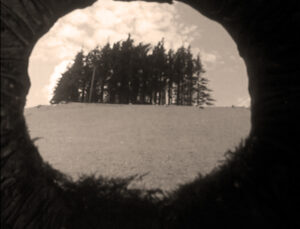Book Review – November 2024
Is nostalgia a harmless skip down memory lane? Can nostalgia be used like propaganda to mollify, entice, and seduce: encouraging us to turn off our critical thinking, stick our heads in the sand, and revel in a past that actually may have never been, a past gone mad? While conservative politicians have made nostalgia an intrinsic and explicit part of their political platform, the social consequences of nostalgia on culture and art can be sinisterly opaque.

Ghost of an Idea examines the impact of nostalgia on the horror and hauntological genres. In this deeply researched work William Burns addresses the question of nostalgia, which can be defined as a longing for a past that may once or may never have existed. Is it, he asks, a force which stimulates contemporary creativity, encouraging further exploration and expression? Or does nostalgia too often produce a culture that is a bland shadow of the original upon which it is based?
The term ‘hauntology’ came into common use in cultural studies circles as a result of its being employed by the French philosopher, Jacques Derrida, in his 1993 book Spectres of Marx. The British academic, Mark Fisher, further developed the concept of hauntology, applying it to manifestations of popular culture and popularising the term in the English-speaking world. Hauntology explores the ways in which nostalgia, memory, and the remnants of past ideologies manifest in contemporary culture, art, and media. It looks at how the past ‘haunts’ the present, creating a sense of temporal disjunction.
In Ghost of an Idea William Burns considers a comprehensive range of horror and hauntological films, television programmes, literature and music, displaying considerable knowledge and great affection for his subject matter. The book’s format is very much like that of an anthology. It starts with what Burns describes as a ‘hauntology primer’ and then goes on to discuss manifestations of this concept in the arts. Burns’ love of the types of music influenced by hauntology is reflected by a series of interviews he conducted with musicians and reviews of gigs that he attended that he reproduces here. Hauntological music is hard to define, but embraces the folk, electronic, ambient and rock traditions.

Boards of Canada
He presents a convincing argument as to why Charles Dickens’ A Christmas Carol should be regarded as the ‘first truly hauntological work of art’ and goes on to closely consider the works of other writers such as H P Lovecraft and Alan Moore. Film (and by extension television) is possibly, the perfect medium for works of hauntology as its creators are able to use such devices as jump cuts and flashbacks and are not bound by a linear narrative structure.
Childhood is an important trope in hauntological art as the innocence, expectations, and fears of the foggily remembered past and the anticipated future are expressed through the intermingling of the thrills and the dread of the ordinary…the extraordinary…and the apocalyptic.
As a child of the 1970s Burns’ is haunted by memories of the children’s television of that period. Indeed, he’s not the first to observe that some of the programmes supposedly aimed at kids from that period were decidedly weird.

The Owl Service
The final part of Ghost of an Idea addresses the question posed it its title: The Enemy of Truth: Is Nostalgia Counter-Revolutionary? Burns does not sit on the fence. With justifiable wit and anger he turns his ire upon the franchise merchants, The people who take what was once an original idea and a landmark film and milk it for all its worth with sequels and remakes. In the process they denigrate everything that was good about the original.
Horror fans are now a prime target audience and marketing demographic meant to be milked the same way that all the other fandoms are. Horror and its fans were the outsiders, the neglected, the underdogs, even the despised for being interested in the transgressive, darker aspects of human experiences. Now we are merely consumer metrics.
Particular targets for Burns’ wrath are the Stars Wars films since the founding trilogy, American Horror Story Season 10 and the Toy Story merchandising machine. On a positive note, however, he applauds the integrity of Alan Moore who refused to simply bow down and take the Hollywood dollar.
Just a word though in defence of Randy Newman (misspelt Neumann in my copy of the book). While Burns is no doubt entirely right to describe his Toy Story film scores as ‘maudlin’, Newman also has a singer/songwriter back-catalogue going back some fifty years in which he consistently exposes the dark side of the American dream with wit and eloquence.
William Burns
William Burns was born in 1972 upon a day when, he likes to point out, crucial scenes for both The Exorcist and The Wicker Man were being filmed, forever marking him out as a member of the ‘Haunted Generation’. He is the author of The Thrill of Repulsion: Excursions into Horror Culture (2016).

Not one for me (too feeble!) but a lovely book design and yes, children’s TV could be terrifying, hence my abiding fear of the White Horse of Uffington!
Thanks Liz. As I mentioned in a previous review, I’m not a huge horror fan myself, but this was a fascinating read.